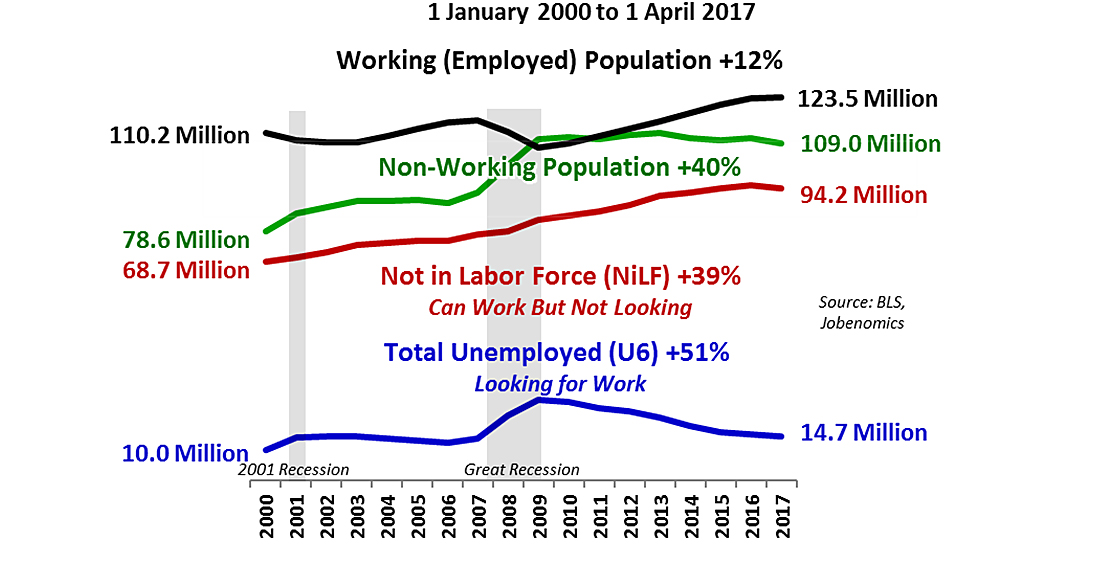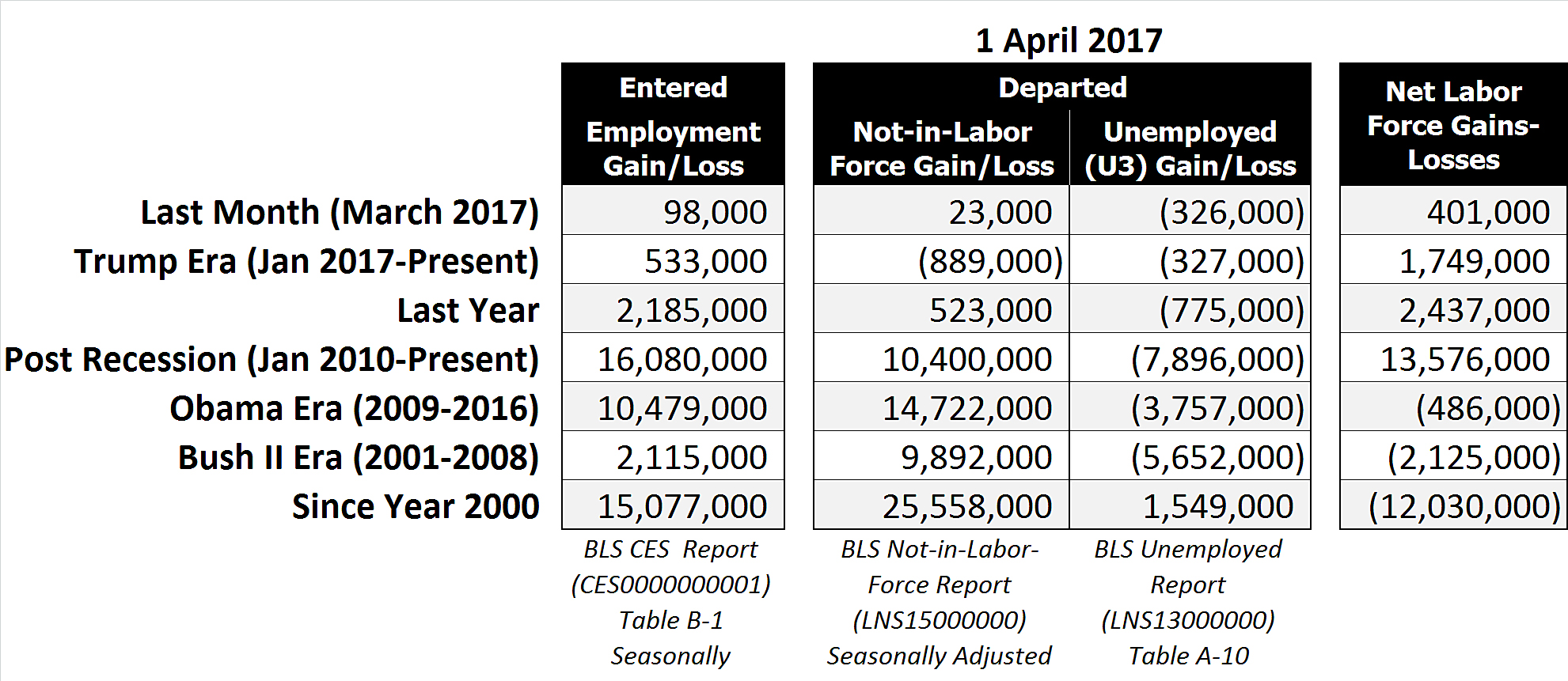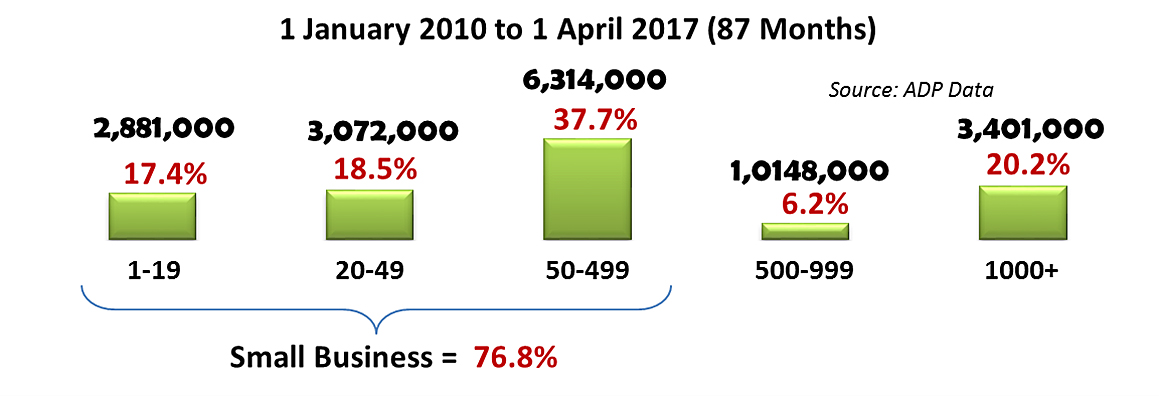Jobenomics U.S. Employment Analysis: 15 April 2017
The two primary sources for U.S. labor force data are the monthly U.S. Bureau of Labor Statistics (BLS) Employment Situation Summary, a monthly summary of all U.S. government and private sector employment, and the ADP National Employment Report, a monthly survey of employment by 400,000 U.S. private sector businesses by the ADP Research Institute in collaboration with Moody’s Analytics. The BLS’ March Situation Summary reported a disappointing 98,000 new jobs, which was less than half the number expected due to a large late winter storm that keep hundreds of thousands of people from work. The ADP Report, released several days earlier, reported a resounding number of 263,000 new jobs—83% by small business.
Notwithstanding poor BLS March performance figures, overall labor force performance for the first 3-months of 2017 reflected a positive start for the new Trump Administration with the creation of over ½ million new jobs plus a significant reduction of the number of unemployed and voluntary departures to the U.S. labor force as discussed herein.
President Trump’s vision of a “dynamic and booming economy” ultimately depends on mass-producing business, especially small business, creation in order to generate 25 million net new jobs. While the United States posted slow but steady gains during the post-recession era, the U.S. labor force is still 12,030,000 weaker today in terms of gainfully employed workers. It is also important to note that today’s weakened labor force statistics is not adjusted for population growth of 43 million additional Americans compared to year 2000 (282 million versus 325 million).
From a Jobenomics standpoint, President Trump’s “bold plan to create 25 million new American jobs in the next decade and return to 4 percent annual economic growth” is an achievable goal but fraught with significant challenges as addressed in detail in the Jobenomics 130-page, 20-part series entitled President Trumps New Economy Challenge.
To get a strategic perspective of the state of the U.S. labor force and workforce issues facing the Trump Administration, one must compare the Working Population (Employed) against the Non-Working Population (Unemployed and Not-in-Labor-Force).
Working Versus Non-Working Populations
As shown, from 2000 to 2017, the Working (Employed) population rose by 12% compared to the Non-Working Population rise of 40%. Jobenomics defines the Non-Working Population as Not-in-Labor Force (that rose by 39%) and Total Unemployed (which is still 51% higher today than year 2000). If these trends continue, Jobenomics predicts that the U.S. Not-in-Labor-Force will equal the Employed population by the mid-2020s, or sooner if the United States suffers a major financial crisis.
Historical Perspective of U.S. Labor Force Gains and Losses Since 2000
The Bureau of Labor Statistics (BLS) Employment Situation Summary reported that last month (March 2017), 98,000 Americans entered the U.S. labor force, 23,000 more Americans were recorded in the BLS’ “Not-in-Labor-Force” category (a category reserved for able-bodied Americans who choose not to work and voluntarily depart the workforce), and 326,000 less citizens were categorized as officially unemployed, for a net workforce gain of 401,000 Americans.
This combination of labor force gains and losses in March 2017 was highly unusual inasmuch as weak labor force gains (98,000) and increasing labor force departures (23,000) were more than offset by a reduction in unemployment (326,000). The significant decrease in the unemployment rolls marked a 10-year low of 4.5% in the official U3 employment rate.
From a quarterly perspective, BLS data indicates that over the first three months (January, February and March) of the Trump presidency, the net labor force gain was 1,749,000 (an average of 583,000 jobs per month), which represents 72% of all net labor force gains over the last year (2,437,000) and 13% of all gains in the 87-months since the beginning of the decade (13,576,000). What is particularly noteworthy regarding President Trump’s first quarter labor force statistics is the drop of 889,000 people in the “not in the labor force” category (i.e., capable of working but not looking). Apparently, the new Administration is giving people a reason to rejoin the workforce. However, while very positive, this Trump-bump does not necessarily indicate a long-term trend.
From a historical perspective, post-recession/decade, past-president and turn-of-the-century labor force statistical BLS data is also presented:
- Since the end of the Great Recession, beginning on 1 January 2010, the U.S. labor force improved by 13,576,000 workers for an average of 162,000 job per month. 16,080,000 entered the labor force, 10,400,000 voluntarily departed, and 7,896,000 fewer people were recorded as officially unemployed. It is important to remember that to be recorded as unemployed one must be looking for work. If one quits looking, they are recorded as “not in the labor force” – a separate BLS category.
- During the 8-years/96-months of the Obama Administration (1 January 2009 to 31 December 2016), the U.S. labor force lost a net 486,000 jobs. It is important to note that President Obama took office during the last 6-months of Great Recession.
- During the 8-years/96-months of the Bush Administration (1 January 2001 to 31 December 2008), the U.S. labor force lost a net 2,125,000 jobs, which included the first 12-months of Great Recession, the 8-months of the 2001 Recession (March 2001–November 2001), as well as the aftermath of the September 11, 2001 attacks.
- From 1 January 2000 to 1 April 2017, the American labor force is weaker by 12,030,000 since the advent of the new century not including for population growth of 43 million or the influx of about 3 million new undocumented immigrants. As of 1 April 2017, the BLS reports that the private sector workforce consists of 123,540,000 workers or only 38% of the population.
U.S. Private Sector Employment by Company Size
As reported by the ADP National Employment Report, small businesses are undeniably the dominant employer and job creator in the United States. According to ADP, small businesses with less than 500 employees employ 77.2% of all private sector Americans with a total of 95,621,721 employees—over 3.4-times the amount of large businesses with more than 500 employees that have 28,162,205 employees. Micro and self-employed businesses with 1-19 employees employ 1.6-times the number of major corporations with over 1,000 employees (31,159.668 versus 19,785,301).
U.S. Private Sector Jobs Created This Decade by Company Size
Since the beginning of this decade, small businesses created 76.8% of all new jobs in the United States. Small businesses with less than 499 employees created 2.8-times more jobs as large businesses with over 500 employees, or 11,956,336 versus 4,290,183 new jobs respectively.
U.S. Private Sector Jobs Created Last Month by Company Size

Last month (March 2017), U.S. small business created 83.0% of all new U.S. jobs. While most of the America’s and the world’s attention is focused on the Trump Administration’s big business focus (e.g., reshoring jobs and trade policies), it is small business that produced 218,640 (83%) out of the record 263,480 new private sector jobs last month.
In conclusion, during President Trump’s initial three months in office, the Administration has averaged 259,000 new jobs per month according to ADP data. While it too early to predict whether or not this aggressive amount of job creation will lead to continued job growth above the 250,000 new jobs per month standard, initial indications are positive.
Notwithstanding initial indicators, U.S. economic growth depends on GDP growth that is dependent on labor force growth. According the nonpartisan Congressional Budget Office’s 2017 to 2027 Budget and Economic Outlook report, “over the next five years, the monthly increase in nonfarm payroll employment, which is estimated to average 160,000 jobs in the first half of 2017, is projected to settle down to an average of 64,000 jobs.” If the CBO outlook is correct, the next decade is likely to produce only 9 million jobs, which is far short of President Trump’s projection of 25 million new jobs. Last year’s BLS Employment Projections: 2014-24 Summary report forecasts that the United States will produce only 9.9 million new jobs over the next decade.
Jobenomics tends to agree with the CBO and BLS for the reasons discussed in the Jobenomics 130-page, 20-part series entitled President Trumps New Economy Challenge. However, the Trump Plan can be amended to ameliorate the CBO and BLS projected shortfalls. With proper leadership, the Administration can lift tens of millions of Americans out of poverty by making the following four structural changes to President Trump’s economic and job creation plan:
- Balancing the old traditional standard industrial economy with the newly emerging nonstandard digital economy,
- Mitigating the mass-exodus of able-bodied workers who are voluntarily departing the U.S. labor force for lives of dependency or alternative lifestyles,
- Addressing the challenge of the ever growing contingency workforce that will soon be the dominate form of labor in the United States, and
- Mass-producing small and self-employed businesses—the engine of the U.S. economy—and the employer of the vast majority of Americans.
If the Trump Administration can achieve a sustainable 4% GDP in a stable global economy, Americans and the world will be euphoric. This feat will not be easy. The last year the United States breached 4% in a single year was 2001. The last time that the United State reached 4% over ten consecutive years over the last 50-years was never (3.5% was the highest from 1976 to 1985). If the Trump Administration can tie the 3.5% record over the next decade, they will be vindicated and worthy of much praise. The Federal Reserve’s latest projection for U.S. economic growth is between 1.5% and 2.4% during the next four to five years.
Like citizens from Missouri, most American’s now claim the “Show-Me” sobriquet. To date, Jobenomics has not seen adequate evidence from President Trump that the new Administration will be able to achieve his Administration’s lofty, but greatly needed, economic and job creation goals. To this end, Jobenomics published a 20-part series (130-pages) on President Trump’s New Economy Challenge that is available to subscribers or purchase.
About Jobenomics: Jobenomics deals with economics of business and job creation. The non-partisan Jobenomics National Grassroots Movement’s goal is to facilitate an environment that will create 20 million net new middle-class U.S. jobs within a decade. The Movement has a following of an estimated 20 million people. The Jobenomics website contains numerous books and material on how to mass-produce small business and jobs. Monthly website traffic exceeds one-half million hits, which is indicative of the high level of public interest regarding economic, business, labor force and workfare solutions. For more information, see Jobenomics Overview.







